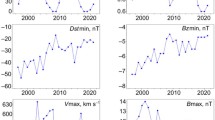Abstract—
Based on an analysis of the F2-layer critical frequency (foF2) at Irkutsk station during the extreme storm of March 13–15, 1989, it is found that geomagnetic activity index aa is a more adequate indicator than ap for foF2 during the maximum of an extreme storm. This is related to the existence of the upper limit of changes in ap (ap = 400) and this fact imposes some limitations on using the ap index for extreme events. In the initial period of the recovery phase of the considered storm, a rapid decrease of geomagnetic activity occurred. A strong deviation of the experimental values of foF2 from the values calculated by the semi-empirical model, which considers the dependences of the thermospheric temperature and composition on geomagnetic activity by the NRLMSISE-00 atmospheric model, was observed during that period. It is assumed that this could be related to the effect of disturbance of thermospheric wind velocity due to the rapid decrease of geomagnetic activity. This assumption is rather qualitative and requires a special study.






Similar content being viewed by others
REFERENCES
Araujo-Pradere, E.A., Fuller-Rowell, T.J., and Codrescu, M.V., STORM: An empirical storm-time ionospheric correction model. 1. Model description, Radio Sci., 2002, vol. 37, no. 5, pp. 3-1–3-12. https://doi.org/10.1029/2001RS002467
Picone, J.M., Hedin, A.E., Drob, D.P., and Aikin, A.C., NRLMSISE-00 empirical model of the atmosphere: Statistical comparisons and scientific issues, J. Geophys. Res., 2002, vol. 107, no. A12, pp. SIA 15-1–SIA 15-16. https://doi.org/10.1029/2002JA009430
Annakuliev, S.K., Deminov, M.G., and Shubin, V.N., Semiempirical model of a storm in the midlatitude ionosphere, Soln.–Zemnaya Fiz., 2005, no. 8, pp. 145–146.
Prölss, G.W., Density perturbations in the upper atmosphere caused by the dissipation of solar wind energy, Surv. Geophys., 2011, vol. 32, no. 2, pp. 101–195.
Rostoker, G., Geomagnetic indices, Rev. Geophys. Space Phys., 1972, vol. 10, no. 4, pp. 935–950.
Menvielle, M. and Berthelier, A., The K-derived planetary indices: Description and availability, Rev. Geophys., 1991, vol. 29, no. 3, pp. 415–432.
Coffey, H.E. and Erwin, E.H., When do the geomagnetic aa and Ap indices disagree?, J. Atmos. Sol.-Terr. Phys., 2001, vol. 63, no. 5, pp. 551–556.
Hedin, A.E., MSIS-86 thermospheric model, J. Geophys. Res., 1987, vol. 92, no. A5, pp. 4649–4662.
Deminov, M.G., Deminova, G.F., Zherebtsov, G.A., and Polekh, N.M., Properties of the F2 layer maximum density variability over Irkutsk under different levels of solar and geomagnetic activity, Soln.–Zemnaya Fiz., 2015, vol. 1, no. 1, pp. 56–62.
Wrenn, G.L., Time-weighted accumulations ap(t) and Kp(t), J. Geophys. Res., 1987, vol. 92, no. A9, pp. 10125–10129.
Kutiev, I. and Muhtarov, P., Empirical modeling of global ionospheric foF2 response to geomagnetic activity, J. Geophys. Res., 2003, vol. 108, no. A1, pp. SIA 5-1–SIA 5-11. https://doi.org/10.1029/2001JA009134
Deminov, M.G. and Deminova, G.F., Geomagnetic activity that corresponds to the median of the F2 layer critical frequency at various latitudes, Geomagn. Aeron. (Engl. Transl.), 2016, vol. 56, no. 5, pp. 572–576.
Deminov, M.G., Deminova, G.F., Depuev, V.Kh., and Depueva, A.Kh., Dependence of the F2-layer critical frequency median at midlatitudes on geomagnetic activity, J. Sol.-Terr. Phys., 2017, vol. 3, no. 4, pp. 74–82.
Rishbeth, H. and Mendillo, M., Patterns of F2 layer variability, J. Atmos. Sol.-Terr. Phys., 2001, vol. 63, pp. 1661–1680.
Deminov, M.G., Zherebtsov, G.A., Pirog, O.M., and Shubin, V.N., Regular changes in the critical frequency of the F2 layer of the quiet midlatitude ionosphere, Geomagn. Aeron. (Engl. Transl.), 2009, vol. 49, no. 3, pp. 374–380.
Richards, P.G., Woods, T.N., and Peterson, W.K., HEUVAC: A new high resolution solar EUV proxy model, Adv. Space Res., 2006, vol. 37, pp. 315–322.
Ma, R., Xu, J., Wang, W., and Yuan, W., Seasonal and latitudinal differences of the saturation effect between ionospheric NmF2 and solar activity indices, J. Geophys. Res., 2009, vol. 114, A10303. https://doi.org/10.1029/2009JA014353
Buonsanto, M.J., Ionospheric storms—a review, Space Sci. Rev., 1999, vol. 88, pp. 563–601.
Klimenko, M.V., Klimenko, V.V., Despirak, I.V., et al., Disturbances of the thermosphere–ionosphere–plasmasphere system and auroral electrojet at 30E longitude during the St. Patrick’s Day geomagnetic storm on 17–23 March 2015, J. Atmos. Sol.-Terr. Phys., 2018, vol. 180, pp. 78–92.
Fuller-Rowell, T., Emmert, J., Fedrizzi, M., et al., How might the thermosphere and ionosphere react to an extreme space weather event?, Extreme Events in Geospace, Elsevier, 2018, pp. 513–539.
Danilov, A.D., Ionospheric F-region response to geomagnetic disturbance, Adv. Space Res., 2013, vol. 52, pp. 343–366.
Shubin, V.N. and Annakuliev, S.K., Model of an ionospheric negative storm phase at midlatitudes, Geomagn. Aeron., 1995, vol. 35, no. 3, pp. 79–87.
Hierl, P.M., Dotan, I., Seeley, J.V., et al., Rate constants for the reactions of O+ with N2 and O2 as a function of temperature (300–1800 K), J. Chem. Phys., 1997, vol. 106, pp. 3540–3544.
Bilitza, D., IRI the international standard for the ionosphere, Adv. Radio Sci., 2018, vol. 16, pp. 1–11.
Lu, G., Goncharenko, L.P., Richmond, A.D., Roble, R.G., and Aponte, N., A dayside ionospheric positive storm phase driven by neutral winds, J. Geophys. Res., 2008, vol. 113, A08304. https://doi.org/10.1029/2007JA012895
ACKNOWLEDGMENTS
The data on critical frequencies foF2 of the Irkutsk ionospheric station and solar activity indices were taken from the sites of Space Physics Interactive Data Resource (SPIDR, http://spidr.ionosonde.net/spidr) and the World Data Centre for Solar-Terrestrial Physics, Chilton (http:// www.ukssdc.ac.uk/wdcc1/). The data on the geomagnetic indies were taken from the site of the International Service of Geomagnetic Indices (ISGI, isgi.unistra.fr). These indices were calculated and presented by the ISGI staff based on the data collected at magnetic observatories. We thank the corresponding national institutions, the NTERMAGNET network, and ISGI.
Funding
The study was partly supported by the Russian Foundation for Basic Research, project no. № 17-05-00427, and Program 28 of the Presidium of the Russian Academy of Sciences.
Author information
Authors and Affiliations
Corresponding author
Additional information
Translated by A. Danilov
Rights and permissions
About this article
Cite this article
Deminov, M.G., Deminova, G.F. Properties of the Ionosphere during an Extreme Storm. Cosmic Res 57, 451–458 (2019). https://doi.org/10.1134/S0010952519060017
Received:
Revised:
Accepted:
Published:
Issue Date:
DOI: https://doi.org/10.1134/S0010952519060017




